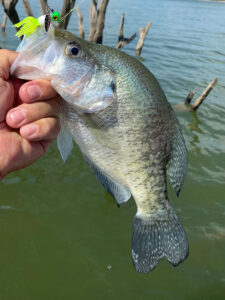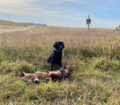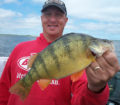By Bob Jensen
Fishing the Midwest Fishing Team

(photo by Bob Jensen) This crappie couldn’t resist the Sausage Spin/Crappie Thunder jig that came near the brush pile that was his home.
As the summer winds down and fall begins, anglers should start thinking about some fall fishing strategies. Fishing opportunities for a wide variety of fish are abundant in the fall across North America.
In many areas, crappies are the primary target. Crappies are fun to catch and they’re great on the table. If you keep a couple of ideas in mind you should be able to have outstanding crappie action until ice covers the lake.
If you want to catch crappies, you’ve got to go to where they live. Crappie location will change from lake to lake depending on what kind of lake you’re fishing. Some lakes and reservoirs will see crappies using deep water away from structure. They’ll be in the basin of the lake maybe 30 feet down. Often they’ll look just like walleyes on your sonar unit.
On other lakes, our quarry will be just off the edge of the weedline, while on other bodies of water they’ll be around brush piles or manmade cribs. It will help you find the fish faster if you do some research before you actually hit the water. Ask your fishing friends or at bait shops which areas appeal to the crappies on the lakes you’ll be fishing.
If the lake you’re on is a brush pile and crib lake, find those targets and fish around them. Wally Marshall is better known as Mr. Crappie. He has competed in the biggest crappie tournaments in North America with much success. He says that a Sausage Head jig with a Crappie Thunder tail is his go-to bait around brush piles and cribs, but that rig catches crappies almost anywhere, almost anytime. He likes the Sausage Head Spin jig with a Mr. Crappie Grub when the water has some stain.
If it’s a weedline lake, you’re going to have to look around a bit for Mr. Papermouth. Cast to the weedline, but also be aware that frequently crappies will be near the surface away from the weedline. Watch for dimples on the surface of the water. Minnows will often be out there eating plankton off the surface and the crappies will be just below eating the minnows.
On basin lakes, cruise the deep basin areas with a close eye on your depthfinder. Watch for concentrations of fish life. If you see what you think are crappies on the bottom, drop them a jig. If you see a concentration of suspected crappies suspended, back off and cast to them. Crappies near the surface can be spooky fish.
When the crappies are on the bottom, tip a jig with a Crappie Thunder tube and put it right on their nose. They usually can’t resist that presentation.
When you’re casting for suspended crappies, swim that Mr. Crappie Grub mentioned previously on a sixteenth ounce jighead through the fish. Use a light or medium-light action rod spooled with four or six pound test line for the best castability and sensitivity.
Here’s a very important consideration. Crappies that are in deep water are often difficult to release. The change in pressure from the bottom of the lake to the surface makes bad things happen to them. Keep a few, but remember that releasing them is probably not going to be successful.
If you want to catch and release, go after the shallower fish. Once you learn how much fun crappie catching can be, you’re going to want to make sure that there’s some left for next time.














